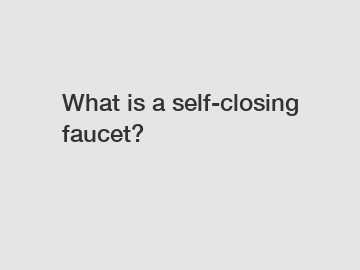What is a self-closing faucet?
What is a self-closing faucet?
A self-closing faucet, also known as a metering faucet or a push-button faucet, is a type of faucet that automatically shuts off the flow of water after a certain period of use. This innovative design is equipped with a mechanism that controls the water flow, providing a convenient and efficient solution for water conservation.
The concept of self-closing faucets originated from the need to promote sustainability and conserve water resources. As water scarcity becomes a pressing issue globally, it is crucial to develop effective measures to reduce water wastage. Self-closing faucets serve as a practical solution, allowing individuals to contribute towards water conservation efforts in their everyday lives.

The functioning of a self-closing faucet is relatively simple yet effective. When the user presses the push-button or activates the lever, the faucet opens and releases a controlled amount of water. After a set period, usually a few seconds, the faucet automatically shuts off, preventing any unnecessary wastage. This mechanism ensures that water is only used when required, eliminating the possibility of leaving faucets running unintentionally.
The significance of self-closing faucets lies in their ability to curb excessive water usage. Traditional faucets often result in water being left running unintentionally due to forgetfulness or negligence. This not only wastes water but also increases water bills for households and consumes energy required for water treatment and transportation. By incorporating self-closing faucets, households, public facilities, and commercial spaces can effectively reduce water wastage, thus promoting water conservation on a larger scale.
Moreover, self-closing faucets also have health and hygiene benefits. In public spaces, where the usage of faucets is frequent, these faucets minimize the risk of cross-contamination. Traditional faucets require users to physically touch the handle, which can potentially transmit germs and bacteria. With self-closing faucets, users only need to press the button or lever, eliminating direct contact with the faucet. This added hygiene feature ensures the well-being of individuals, particularly in high-traffic areas like hospitals, schools, and restaurants.
The impact of self-closing faucets is not limited to water conservation and hygiene. These faucets also have a positive effect on reducing maintenance and repair costs. As self-closing faucets have a built-in mechanism that prevents excessive wear and tear, they tend to last longer compared to traditional faucets. This significantly reduces the need for frequent repairs and replacements, saving both time and money for households and establishments.
In conclusion, a self-closing faucet is a faucet that automatically shuts off the water flow after a certain period. Its origin stems from the imperative need for water conservation. By implementing self-closing faucets, individuals contribute to global sustainability efforts, promote hygiene, and save on water and maintenance costs. Embracing this innovative solution not only benefits the environment but also brings practical advantages to households, public facilities, and businesses.
If you are looking for more details, kindly visit oem good price angle valve factory, double handle mixer manufacturer, wholesale double handle mixer tap.


